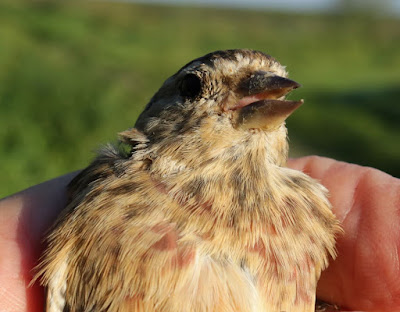A wander out Pilling way on Sunday saw activity of mainly egrets, pipits and Linnets along the sea wall. Two identical looking Wheatears caught my eye so I stopped for a closer inspection.
The tidal defences here keep Morecambe Bay tides at bay with a high raised earth bank, (a bund) interspersed with sections consisting of large rocks and stones. The rockery is an attraction to migrant birds where crevices and holes out of prevailing winds provide a sanctuary to insects attractive to Wheatears and other insectivores.
Over many years I have ringed over seventy Wheatears along Pilling shore, until taking a break in recent years when human and canine disturbance made the job impossible. Having recently found a new private spot, and even in the limited possibilities of September when their numbers decline, the desire to catch Wheatears resurfaced with the appearance of these two Wheatears. I suspect the two were siblings so closely did they resemble each other and to follow in each other’s movements.
Luckily mealworms were at hand together with a couple of spring traps that caught one bird quite easily as the other scooted into the distance upon seeing its companion compromised inside a tent of netting.
Wheatear
Wheatear
After a few days off I met up with Will and Andy on Thursday at 0630 for a go at the Linnets and anything else linked to the month of September. Thirteen birds caught/ringed - 6 Linnet, 5 Meadow Pipit, 1 Goldfinch, 1 Robin.
We have to remind ourselves that male Linnets are normally a touch larger than females but this is never the decider between male or female. The most reliable method is the amount of white on the outer web of the primary wing feathers numbers 7 to 9. A gap of less than 5mm from the white feather to the centre shaft tells us the bird is a male, more than 5mm a female. In other words, males have more white in the wing, a feature that is sometimes discernible with Linnets in flight, more easily picked out ina large flock rather than isolated birds.
Very often autumn males show brown/rufous rounded markings on the breast, unlike a female which is more streaked.
Linnet female September
It is not surprising that about 80/90 % of autumn Meadow Pipits we catch are first summer/juveniles as the species is able to raise two broods of youngsters in a normal summer. The juvenile below is already part way through its post-juvenile moult.
Meadow Pipit
Other birds seen and not caught - 50+ Linnet, 50+ Meadow Pipit, 8/10 Tree Sparrow, 2 Blackbird, 1 Kingfisher, 1 Marsh Harrier, 1 Peregrine overhead.
Kingfisher
Fifteen Pink-footed Geese arrived from the north and landed on the salt marsh. The first of the Autumn.
Log in again soon everyone.
There’s always news, views and pictures of The Real World on Another Bird Blog.
Linking this weekend to Eileen's Saturday
.







.JPG)






.jpeg)








.jpg)













11 comments:
Lovely photographs of the Wheatear, Linnet and Meadow Pipit.
It's been very hot down South, I'm looking forward to a slightly cooler week next week!
Enjoy the coming weekend.
All the best Jan
Great post! Thank you for the tips for distinguishing male and female linnets.
Hello Phil,
Great catches, I love the closeups of the Wheatear, Linnet and the Meadow Pipit. It is nice that in September there are less humans at the shore, they are back to work and school. Great photos, happy birding. Thank you for linking up and sharing your post. Take care, have a great weekend.
Despite our intense human efforts to affect the order of the natural world, seasons continue to change. Summer this year may be warmer or cooler than a million years ago. It depends on which media you choose to read.
The birds just don't care. They know it's time to pack the luggage and wing it to a warmer clime if they expect to survive in order to breed again.
Citizen scientists may not receive huge financial grants to report findings. But the work you do, my friend, is of the old-fashioned variety. Honest.
Terrific visit to Pilling it seems to me. It's not every day one can see twin Wheatears. Great information on Linnet identification.
Gini and I are well and enjoying more birding days than doctor days. A good ratio. Hope your travel plans are complete and don't forget to pack the sun lotion.
Beautiful snaps of the birds. Very beautiful work and models.
Happy WE!
Another fine post Phil. I don't get out much so to see what you and the others get up to is a real treat. Take care. Mike
Wheaters are attractive birds. I like the way the color lightens from the chest down.
I like the wheatear and the kingfisher is gorgeous!
Sorry I'm late for the show :) I'm glad your days have given you some birds to be banded. Anytime a kingfisher photo is shown, I'm a happy camper. Can't get enough of those cute birds.
Hi Phil, sorry I am so slow at the moment. Too much going on with the garden, and all the fruit of which we seem to have so much more than usual this year. After a short, but heavy storm today, I have picked up a couple of bags of quinces so lots more work for me to do. We also have two lunches to go to this week which slows me up further.
Lovely set of photos, love the Wheatear not a Bird I have knowingly ever seen.
I will get back to blogging one day!! Take care and keep well Diane
Lovely photos as always, Phil.
The Kingfisher is my favourite.
Happy Thursday!
Post a Comment